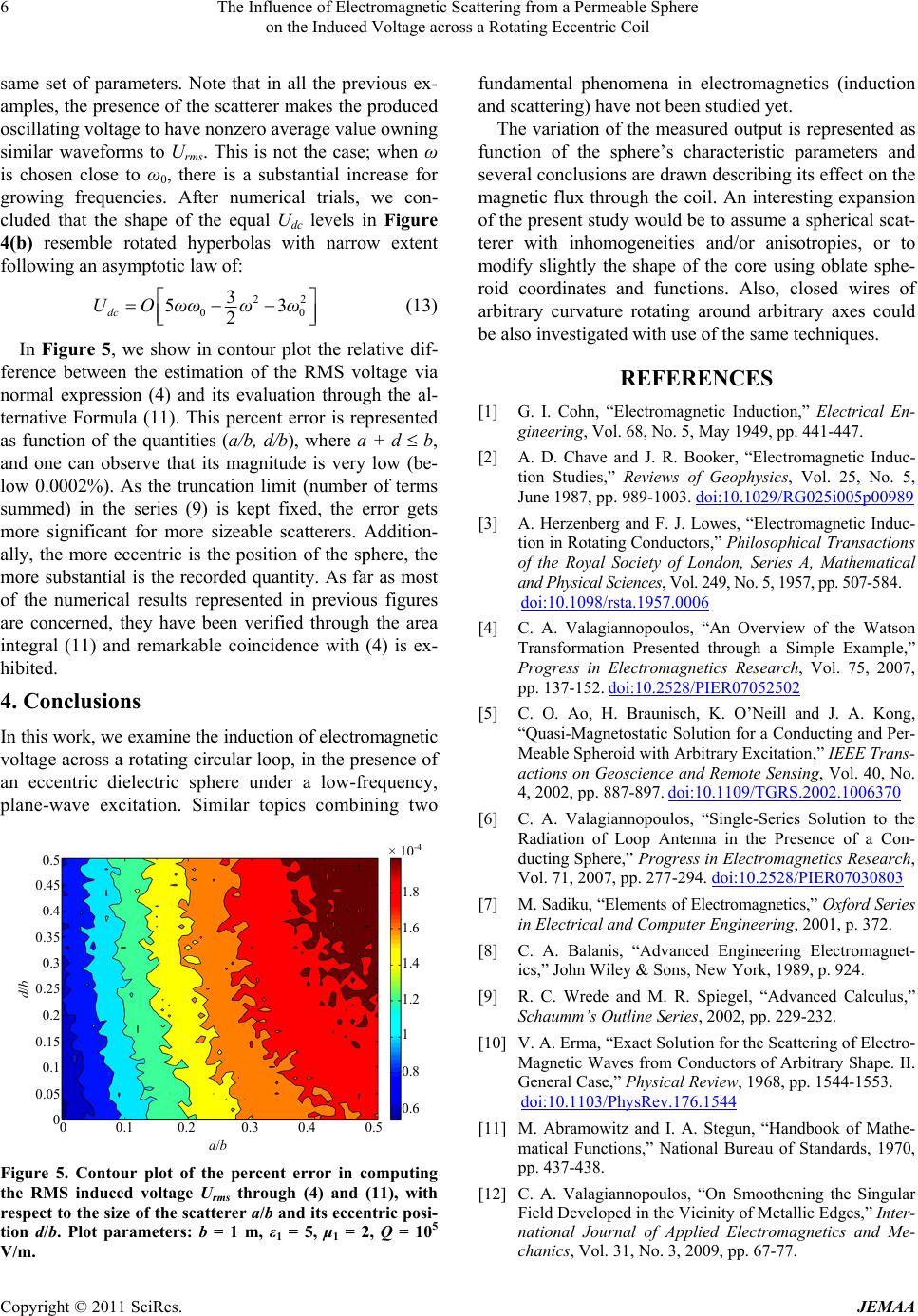
The Influence of Electromagnetic Scattering from a Permeable Sphere
on the Induced Voltage across a Rotating Eccentric Coil
Copyright © 2011 SciRes. JEMAA
6
same set of parameters. Note that in all the previous ex-
amples, the presence of the scatterer makes the produced
oscillating voltage to have nonzero average value owning
similar waveforms to Urms. This is not the case; when ω
is chosen close to ω0, there is a substantial increase for
growing frequencies. After numerical trials, we con-
cluded that the shape of the equal Udc levels in Figure
4(b) resemble rotated hyperbolas with narrow extent
following an asymptotic law of:
fundamental phenomena in electromagnetics (induction
and scattering) have not been studied yet.
The variation of the measured output is represented as
function of the sphere’s characteristic parameters and
several conclusions are drawn describing its effect on the
magnetic flux through the coil. An interesting expansion
of the present study would be to assume a spherical scat-
terer with inhomogeneities and/or anisotropies, or to
modify slightly the shape of the core using oblate sphe-
roid coordinates and functions. Also, closed wires of
arbitrary curvature rotating around arbitrary axes could
be also investigated with use of the same techniques.
22
0
3
5
2
dc
UOωωω ω
0
3
(13)
In Figure 5, we show in contour plot the relative dif-
ference between the estimation of the RMS voltage via
normal expression (4) and its evaluation through the al-
ternative Formula (11). This percent error is represented
as function of the quantities (a/b, d/b), where a + d b,
and one can observe that its magnitude is very low (be-
low 0.0002%). As the truncation limit (number of terms
summed) in the series (9) is kept fixed, the error gets
more significant for more sizeable scatterers. Addition-
ally, the more eccentric is the position of the sphere, the
more substantial is the recorded quantity. As far as most
of the numerical results represented in previous figures
are concerned, they have been verified through the area
integral (11) and remarkable coincidence with (4) is ex-
hibited.
REFERENCES
[1] G. I. Cohn, “Electromagnetic Induction,” Electrical En-
gineering, Vol. 68, No. 5, May 1949, pp. 441-447.
[2] A. D. Chave and J. R. Booker, “Electromagnetic Induc-
tion Studies,” Reviews of Geophysics, Vol. 25, No. 5,
June 1987, pp. 989-1003. doi:10.1029/RG025i005p00989
[3] A. Herzenberg and F. J. Lowes, “Electromagnetic Induc-
tion in Rotating Conductors,” Philosophical Transactions
of the Royal Society of London, Series A, Mathematical
and Physical Sciences, Vol. 249, No. 5, 1957, pp. 507-584.
doi:10.1098/rsta.1957.0006
[4] C. A. Valagiannopoulos, “An Overview of the Watson
Transformation Presented through a Simple Example,”
Progress in Electromagnetics Research, Vol. 75, 2007,
pp. 137-152. doi:10.2528/PIER07052502
4. Conclusions [5] C. O. Ao, H. Braunisch, K. O’Neill and J. A. Kong,
“Quasi-Magnetostatic Solution for a Conducting and Per-
Meable Spheroid with Arbitrary Excitation,” IEEE Trans-
actions on Geoscience and Remote Sensing, Vol. 40, No.
4, 2002, pp. 887-897. doi:10.1109/TGRS.2002.1006370
In this work, we examine the induction of electromagnetic
voltage across a rotating circular loop, in the presence of
an eccentric dielectric sphere under a low-frequency,
plane-wave excitation. Similar topics combining two [6] C. A. Valagiannopoulos, “Single-Series Solution to the
Radiation of Loop Antenna in the Presence of a Con-
ducting Sphere,” Progress in Electromagnetics Research,
Vol. 71, 2007, pp. 277-294. doi:10.2528/PIER07030803
a/b
0 0.1
0.2
0.3
0.4 0.5
1.8
1.6
1.4
1.2
1
0.8
0.6
0.5
0.45
0.4
0.35
0.3
0.25
0.2
0.15
0.1
0.05
0
d/b
×10
-
[7] M. Sadiku, “Elements of Electromagnetics,” Oxford Series
in Electrical and Computer Engineering, 2001, p. 372.
[8] C. A. Balanis, “Advanced Engineering Electromagnet-
ics,” John Wiley & Sons, New York, 1989, p. 924.
[9] R. C. Wrede and M. R. Spiegel, “Advanced Calculus,”
Schaumm’s Outline Series, 2002, pp. 229-232.
[10] V. A. Erma, “Exact Solution for the Scattering of Electro-
Magnetic Waves from Conductors of Arbitrary Shape. II.
General Case,” Physical Review, 1968, pp. 1544-1553.
doi:10.1103/PhysRev.176.1544
[11] M. Abramowitz and I. A. Stegun, “Handbook of Mathe-
matical Functions,” National Bureau of Standards, 1970,
pp. 437-438.
Figure 5. Contour plot of the percent error in computing
the RMS induced voltage U
rms through (4) and (11), with
respect to the size of the scatterer a/b and its eccentric posi-
tion d/b. Plot parameters: b = 1 m, ε1 = 5, μ1 = 2, Q = 105
V/m.
[12] C. A. Valagiannopoulos, “On Smoothening the Singular
Field Developed in the Vicinity of Metallic Edges,” Inter-
national Journal of Applied Electromagnetics and Me-
chanics, Vol. 31, No. 3, 2009, pp. 67-77.